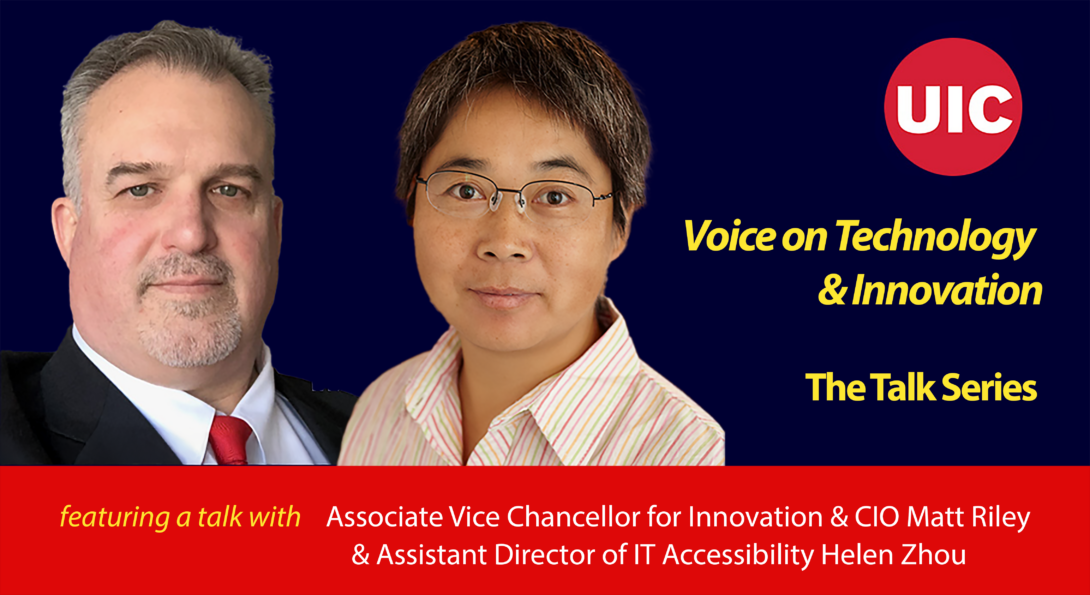Building a Future-Ready, Inclusive Digital Campus: A Talk with UIC CIO Matt Riley & Assistant Director of IT Accessibility Helen Zhou

Introduction
In the post-pandemic era, higher education institutions face complex challenges—and exciting opportunities—at the intersection of technology, equity, and innovation. At UIC, these conversations are not theoretical. They’re shaping real decisions about how the university supports its students, faculty, and staff.
In this special Voice on Technology & Innovation Talk Series edition, we hear from Matt Riley, Associate Vice Chancellor for Innovation and Chief Information Officer, and Helen Zhou, Assistant Director of IT Accessibility, as they offer complementary perspectives on the university’s digital transformation. Riley addresses how Technology Solutions is navigating budget constraints, increasing demand for innovation, and rising expectations from the UIC community. He reflects on the need to balance sustaining infrastructure with investing in forward-looking technologies—while always keeping student success and institutional priorities front and center.
Zhou, a campus leader in accessibility, offers a focused lens on how digital inclusion is central to equity and compliance, but more importantly, to UIC’s cultural values. She shares how accessibility is being embedded across campus workflows—from procurement to training to system design—and how initiatives like the UIC Accessibility Liaison Program are transforming awareness into institutional change.
Together, Riley and Zhou illuminate how accessibility is not a technical afterthought but a catalyst for better design, stronger outcomes, and more equitable participation. Their insights reflect a shared vision: that digital transformation at UIC must be inclusive, strategic, and grounded in community needs. As accessibility laws tighten and technologies evolve, their work exemplifies how universities can lead with intention, responsibility, and innovation.
Q & A with CIO & Associate Vice Chancellor for Innovation
The key long-term priorities for IT accessibility at UIC are to provide completely accessible technology in all directions for the university. This is not entirely possible with current options in technology… but our goals and our ability to meet these goals are always aligned to creating the most accessible environment that we can for our students, staff, and faculty.
| CIO & Associate Vice Chancellor for Innovation
Navigating Constraints: Balancing Innovation, Accessibility, and Infrastructure at UIC

How are current budget constraints shaping both the strategic direction and daily operations of Technology Solutions at UIC?
Matt Riley: Budget constraints at UIC are causing our IT to have serious challenges in supporting the technology that the UIC community has become so dependent on in a post COVID world. Some of the main challenges right now include sustaining the extended physical and virtual infrastructure, sustaining all of the new and increasingly costly enterprise applications that the community uses, staying innovative while our time is dominated with operations, and leading needed technological change. We do get funds, and in particular we’ve had investments in our technology infrastructure across the board. The major challenge is funding/fueling IT needs with current budget constraints and priorities in all directions at UIC.
I understand and empathize with all of our Technology Solutions technicians and professionals who keep us up and running every day. I know that our jobs are increasingly complex.
What are some of the most common barriers students or faculty face when accessing digital content or systems?
Helen Zhou: Depending on individual needs, students and faculty may encounter different types of barriers. Common issues include image-only PDFs in online course materials, which are unusable for individuals who rely on assistive technologies such as screen readers. Inaccessible websites are another challenge, often due to a lack of semantic structure or poor color contrast, both of which can make content difficult to navigate or read. Other barriers include interfaces that cannot be operated with a keyboard, as well as audio or video content lacking captions or transcripts.
Recognizing these challenges, we’ve actively promoted accessibility best practices and raised awareness. These efforts are already leading to steady improvements across campus and helping create a more equitable climate for everyone.
In what ways are student or faculty expectations driving change or innovation within UIC’s IT environment?
Matt Riley: The largest way faculty expectations are driving change is their enthusiasm and current efforts with AI. When faculty are pushing the envelope, it really pushes the technology efforts of the campus. Faculty are expecting to have access to data themselves, and for others to have access as well. There are increased expectations that UIC is providing the technology that they need for research and entrepreneurship, and technology for students as they seek high-paying jobs.
What are some misconceptions about IT accessibility that you frequently encounter on campus?
Helen Zhou: A common misconception about IT accessibility is that it benefits only people with disabilities. In reality, accessibility features enhance the experience for all users. For example, captions on videos not only assist individuals who are deaf or hard of hearing but also support students whose first language is not English, as well as those studying in noisy or audio-restricted environments. Additionally, many of us experience temporary disabilities due to injury, illness, or other circumstances. We can all benefit from a better digital space.
Q & A with Assistant Director of Accessibility Helen Zhou
Inaccessible content creates barriers that can hinder or even prevent members of our community from fully participating in teaching, learning, researching, and campus engagement…Digital accessibility is no longer optional or something we can postpone; it’s a legal and ethical responsibility that requires our proactive and ongoing commitment.
| Assistant Director, IT Accessibility Technology Solutions
Designing for Everyone: How UIC Champions Digital Equity in Higher Ed

What does digital accessibility mean in the context of higher education, and why is it foundational to equity and inclusion?
Helen Zhou: In higher education, digital accessibility means fostering an inclusive digital environment that empowers faculty, staff, and students of all abilities to succeed. This involves a broad range of practices, including developing accessible course materials, maintaining an accessible web presence, providing accessible online learning platforms, communicating digitally in an accessible way, and selecting accessible digital tools and applications.
Digital accessibility is fundamental to equity and inclusion because it ensures that all members of the campus community can access information and resources equally. By removing barriers in digital content and systems, we provide everyone with the opportunity to engage, learn, and contribute fully.
What are the key long-term priorities for IT accessibility at UIC, and how are those being influenced by the evolving needs of students and faculty?
Matt Riley: The key long-term priorities for IT accessibility at UIC are to provide completely accessible technology in all directions for the university. This is not entirely possible with current options in technology. Students may find a more inclusive and welcoming UIC if they notice our adherence to digital accessibility. This could lead to increased enrollment and positive ramifications about how UIC is seen. Being compliant is necessary and is increasingly important to keep federal funding, which UIC is very dependent on.
Can you share an example of a recent accessibility initiative or project that had a significant impact at UIC?
Helen Zhou: One recent accessibility initiative at UIC is the launch of the Accessibility Liaison Program, designed to promote a more inclusive digital environment across campus. The program aims to ensure that all digital content is accessible to everyone by supporting compliance with accessibility standards, educating the campus community, and improving digital experiences through feedback and regular audits.
Since its launch in May 2024, the program has engaged over 725 faculty and staff members in digital accessibility training and provided consultation services to more than 24 colleges and departments. It has significantly increased awareness of digital accessibility across campus and helped embed accessibility more deeply into day-to-day practices.
What role does accessibility play within the broader vision of IT innovation at UIC?
Matt Riley: IT accessibility drives us to reconsider our choices with technology and how we develop or adjust it. Our development team is now adept at developing with accessibility in mind. We are looking for design skills with accessibility when we hire. Accessibility is one more thing for IT to think about in everything we do, leading us toward solutions that are inherently accessible.
What challenges do you face in ensuring accessibility is prioritized early in projects rather than as a final check?
Helen Zhou: UIC has made great strides in promoting accessibility from the outset of digital projects, implementing it across the entire procurement, design, and development cycle. Ongoing challenges include fully integrating accessibility into existing workflows and ensuring that all team members have the knowledge, skills, and tools to create accessible content and systems. We’ve made significant progress by collaborating with departments across campus and offering targeted training and guidance. However, maintaining momentum requires continued investment in education, resources, and strong institutional support.
What’s something UIC is doing particularly well right now in IT that you feel other institutions could learn from?
Matt Riley: Other institutions could learn from UIC’s IT being more focused on community needs, especially student needs. We do not simply do IT for the sake of IT. We do things that support our environment in the best, most efficient, and most resourceful way possible. We provide a supportive and inclusive work environment that is helping keep our turnover very low. We have an outstanding group of leaders ranging from individual contributors to a leadership team that is very stable and outstanding.